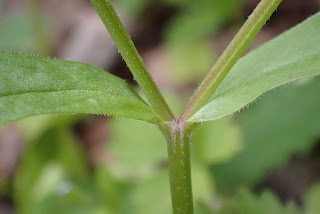Red Valerian, Centhranthus ruber
A member of the Valerianaceae family this is common around here on the dry stone walls. It's a plant from Central and Southern Europe and was a introduction to gardens in the sixteenth century. Well known by the early eighteenth century it has acquired a number of contrasting local names. Grigson in The Englishman's Flora cites American Lilac in Devon, with Bloody Butcher and Queen Anne's Needlework in Somerset. Bouncing Bess, as it is also known in Devon, probably refers to its bouncy blowing in the wind which it was certainly doing on the day I took these photos!
It has large heads of 5-petalled flowers each with a backward directed fine spur. The foliage is blue-green and the stem leaves are opposite and stalkless.
Apparently, it is rather bitter but just about edible in a salad.
Common Cornsalad, Valerianella locusta
Another member of the Valerian family, but a native, this is may be more reliable on the plate as it has been cultivated as Lamb's Lettuce. The pale lilac flowers are tiny, 5-petalled and in clusters.
The stems are finely ridged and repeatedly forked with a pair of leaves at each fork.
Forget-me-not, Myosotis sylvatica
A member of the Boraginaceae family, a native but probably a garden escapee here. The flowers are large and bright and though not shown the hairs on the stem are erect along its length.
The calyx, developing into this tulip shaped seed pod, is densely covered with curved hairs and many hooked ones.
The name Forget-me-not as applied to the species but not originally to Myosotis sylvatica is, of course, romantic in origin. If you wore it you were not forgotten by your lover. There is a German tale of a knight who picked Water Forget-me-not for his lady as they both walked along a river. He fell in and drowned but threw the flowers to his lady as he was swept away. A warning to those of us who botanise by water!
This brings me to Day 139 of #365DaysofBotany: posting 365 different plants over 365 days. More later in the week. I hope you are enjoying the read.






No comments:
Post a Comment